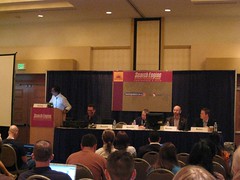So, you’ve launched a search marketing campaign. You spent time and energy putting it all together and now it is live. So how do you track results of the campaign? The panel this morning at SES San Jose shares their knowledge on measurement and tracking in the communicative world of Web 2.0.
Avinash Kaushik kicked us off this morning by talking about how challenging it can be to track results (traffic, links, visibility) from the content placed online. He gave an example of the BBC creating their own content, then distributing that content on their own web channel where users consume that content on the BBC website. However, when Web 2.0 came out and the sense of community and opinion was created, a random Joe Internet can come onto the BBC site and make comments, sharing his thoughts on the BBC website through forums or comments on news stories. Joe also has a blog where he can share his content with the world. And there are news mashups that pull in information from news sites and blogs and it is difficult to find out where the news originated from.
Avinash shares that unless we use multiple tools and unique ways to measure the effects of our content, we may not know how big of a reach we get. Tracking RSS feed subscribers over time compared to posts and finding out exactly where all of your traffic is coming from is just a place to start, and a good place at that.
Jim Sterne comes up next, sharing what we need to look at to satisfy clients in a down economy. Rather than highlighting the biggest and the best product your clients have available, focus a bit more on the products that they are already selling, that they get a lot of conversions from. Try to sell these a bit more and when the economy goes back up, shift over to the new and big thing. Listening to the client this way will ensure you are meeting their objectives and understand their needs as a company.
Matt Bailey followed Jim Sterne with the infamous take on Captain Kirk, Star Trek, and those wearing red shirts. Salting the presentation heavily with pictures of William Shatner is entertaining, of course, but the information behind it is fantastic.
Matt shared that in order to move into analytics of the 2.0 world, we need to ask questions. Gone are the days of sharing data just for data’s sake. Now we need to look at the data and ask questions about it. You think more people wearing red shirts died on Star Trek? Well, you’re right. The data clearly states this. However, when did they die? If you segment the information you find out that over half died when not being on the ship. From this you can see that wearing a red shirt AND beaming down with Captain Kirk is more dangerous than wearing a red shirt and staying on board or wearing a yellow shirt.
So if you wear a red shirt, your life depends on knowing the data, just as a company’s well-being would depend on asking these questions and finding out the reasons behind the data and how to get the best benefit from this data. The questions are key, and will lead us into getting the most out of our campaigns.
To wrap up, Marshall Sponder discussed the use of social media within Web 2.0. Social media is about the conversation, just as Matt Bailey said that it is about asking questions. Having that interaction will get us all up to the next level of measurement and understanding. Marshall shares that in order to get the most conversions, you need to treat the visitors from Twitter differently than the visitors from forums, and differently from the direct visitors.
And within the social space, there are millions of conversations going on daily. But how do you measure this conversation? Marshall mentioned using monitoring tools such as Radian6 to track the effects of a social media conversation. Without measuring the conversation and the outcomes of that conversation, you are missing out on a huge chunk of useful data.
It seems from this panel that the best way to measure web 2.0 success is to ask questions of the data and challenge yourself to find the results in the communication happening between users. These questions and communication could easily generate a new idea for tracking and monitoring, which will benefit clients and companies in the long run.
Keep checking out all of TopRank’s coverage of SES San Jose and sessanjose08 Photos.



